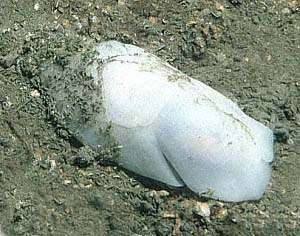
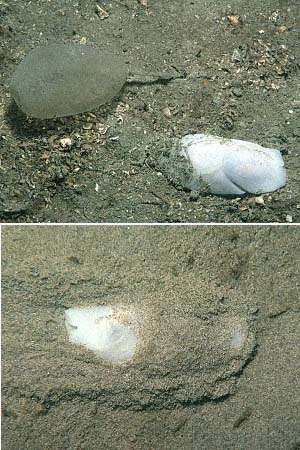
Philine aperta
(Linnaeus, 1767)
Order: CEPHALASPIDEA
Family: Philinidae
DISTRIBUTION
Atlantic coast of Europe and Africa, (including Mediterranean). Records from outside this area probably incorrectly identified.
PHOTO
Photos from Bernard Picton. Note egg mass in middle picture.
Species of Philine feed on bivalves which they crush with three calcareous gizzard plates. P. aperta can grow to over 70mm in length, and like the even larger Philine angasi, from New Zealand and southern Australia, has a broad muscular, wedge-shaped body which is well-designed for burrowing.
See Bernard Picton's observations on its biology below.
References:
• Hansen, B. (1991) Feeding Behaviour in Larvae of the Opisthobranch Philine aperta. 2. Food Size Spectra and Particle Selectivity in Relation to Larval Behaviour and Morphology of the Velar Structures. Marine Biology, 111(2): 263-270.
• Lancaster, S.M. (1983) The biology and reproductive ecology of Philine aperta (Opisthobranchia: Bullomorpha) in Oxwich Bay. J Moll Stud, Suppl 12A: 82-88.
• Thompson, T.E. (1976) Biology of Opisthobranch Molluscs, Volume I. The Ray Society: London. 207 pages
Rudman, W.B., 1998 (October 9) Philine aperta (Linnaeus, 1767). [In] Sea Slug Forum. Australian Museum, Sydney. Available from http://www.seaslugforum.net/find/philaper
Related messages
Philine aperta from east of Cape Town
December 23, 2004
From: Eddie Hardy
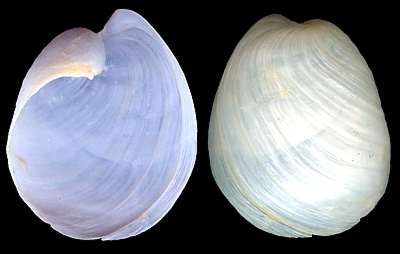
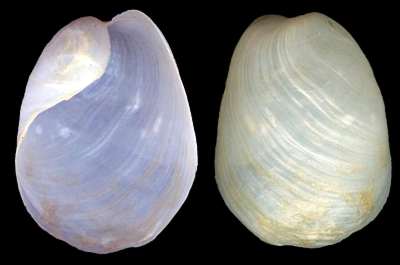
I recently acquired the two shells whose images are attached here. The shells were collected in 1981 in Hermanus which is now a well-known tourist resort about 40 miles along the coast east of Cape Town. The collection is not very accurately ID'd so I would appreciate a view on these two shells. They are both about 40mm long.
Locality: Die Plaat, Hermanus, Depth: not known, South Africa. Atlantic Ocean, [Indian Ocean nominally starts 40 miles or so further east]. 1 June 1981. Photographer: Eddie Hardy.
Thanks,
Eddie Hardy
eddie.hardy1@btinternet.com
Hardy, J.E., 2004 (Dec 23) Philine aperta from east of Cape Town. [Message in] Sea Slug Forum. Australian Museum, Sydney. Available from http://www.seaslugforum.net/find/12808Dear Eddie,
Your shells are probably from Philine aperta. I suspect the apparent difference in shape between the two is just a result of the angle they are photographed at. Macnae (1962) reports it around much of the South African coast from at least Saldanha Bay to Inhaca in Mozambique.
Without a study of its anatomy it's difficult to be 100% sure this species is the same as the common species in Europe and the Mediterranean.There seem to be a group of species around the world with very similarly shaped shells, and similar anatomical characters, such as unequal-sized gizzard plates as described for Philine angasi. It does seem unusual for a European species to also be at home in the Indian Ocean, but it will need someone to have a good look at their anatomy before we can be sure what is going on.
-
Macnae, W. (1962) Tectibranch molluscs from Southern Africa. Annals of the Natal Museum, 15(16): 183 - 199.
Best wishes,
Bill Rudman
Philine aperta from Tunisia
July 26, 2003
From: J. Ben Souissi and A. Eters
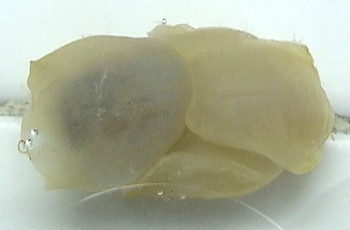
Dear Bill
This is another sea slug collected in the lagoon of Tunis, Tunisia. This nudibranch is very abundant and frequent in the muddy bottom
Depth: 2m
I think it is a Philinidae. Probably Philine quadripartita = Philine aperta?
Many thanks,
Jamila Ben Souissi & Anis Eters
bensouissi.jamila@inat.agrinet.tn
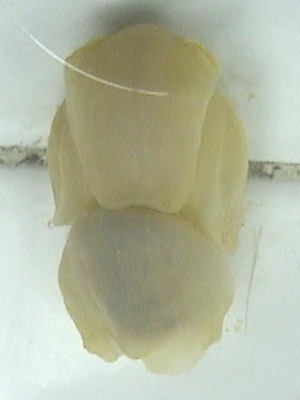
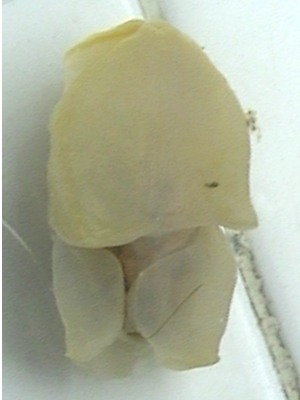
Dear Jamila & Anis,
I am sure this is a species of Philine, and from its shape the most likely identification is Philine aperta. Species of Philine can only be confirmed by checking the shape of the shell, gizzard plates and penial anatomy, but I think P. aperta is the only Mediterranean species with the large muscular parapodial lobes shown in your animal. The name Philine quadripartita is an old synonym of P. aperta.
Best wishes,
Bill Rudman
Philine aperta? from Mediterranean France
December 17, 2001
From: Erwin Köhler
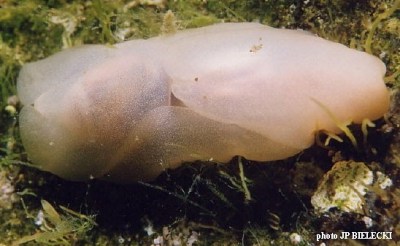
Dear Bill,
Here is a Philine from southern France by Jean-Pierre Bielecki
Email: bielecki.jeanpierre@free.fr
Data: May 14th 2001, Sète, divesite: Étang de Thau depth: 6m, size: 3cm [Mediterranean]
Erwin
Erwin@medslugs.de
Köhler, E., 2001 (Dec 17) Philine aperta? from Mediterranean France. [Message in] Sea Slug Forum. Australian Museum, Sydney. Available from http://www.seaslugforum.net/find/5801Thanks Erwin & Jean-Pierre,
I guess from its size and shape it is probably Philine aperta, but I would appreciate some feedback from those of you with local knowledge.
Best wishes,
Bil Rudman
Photos and observations on Philine aperta
January 25, 1999
From: Bernard Picton
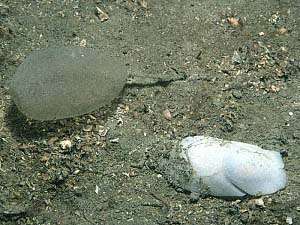
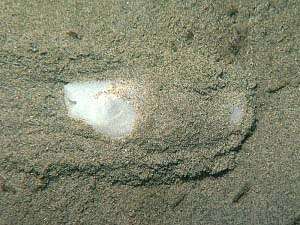
Hi Bill,
I was having a good read through the forum over Christmas, it's really going well!
I enclose two pictures of Philine aperta, as you have a page for this species but no photos. I note that this species lives on soft mud, into which it presumably can burrow, yet normally it is seen moving across the surface leaving a trail. I suspect that some gastropods which feed on bivalves may move at the surface until they encounter a bivalve siphon, then burrow down after it. The prosobranch Natica (now Euspira) seems to do the same thing in my experience. In a big animal like this (3-4 cm) I imagine moving through the sediment would consume considerable energy?
I've copied the message to Chris Duffy, who asked about P. aperta in an earlier message.
We also have observations of Stiliger bellulus(?=Calliopoea oophagus) feeding on the eggs of Philine aperta.
Bernard
bernard.picton.um@nics.gov.uk
Picton, B., 1999 (Jan 25) Photos and observations on Philine aperta. [Message in] Sea Slug Forum. Australian Museum, Sydney. Available from http://www.seaslugforum.net/find/513Bernard,
Thanks for the pictures and information. I have watched the very similar Philine angasi burrowing in New Zealand and it reminds me very much of the way the foot of a tellinid bivalve burrows into quite hard impacted sand. The front of the head narrows and thins, wiggling its way between the sand grains before forcing blood forwards to enlarge the hole through hydrostatic pressure. Your mention of naticids reminds me of watching a remarkable Philine-like naticid, probably Sinum? or Ectosinum? in Tanzania, which burrows much the same way. Naticids can apparently take up water to expand the size of their foot when burrowing, though how they do this doesn't seem very clear.
If you have any photos of Stiliger bellulus to spare they would be an interesting addition to the Forum.
Best wishes,
Bill Rudman.
Philine aperta
October 9, 1998
From: C. Duffy
This is really an appeal for help. I'm just starting my honours project on the ecology of Philine aperta. Information or photos on the beast would be gratefully received.
Thankyou in anticipation.
Chris Duffy.
biocld@pp.hw.ac.uk
Duffy, C., 1998 (Oct 9) Philine aperta. [Message in] Sea Slug Forum. Australian Museum, Sydney. Available from http://www.seaslugforum.net/find/254Dear Chris,
Tom Thompson's Biology of Opisthobranch Molluscs, Vol.1 published by the Ray Society, 1976, covers most of the relevant literature up until then. There has been some later work on anatomy and phylogeny since then but here are a couple on general biology and ecology that I know of.
Hansen, B. 1991. Feeding Behaviour in Larvae of the Opisthobranch Philine aperta. 2. Food Size Spectra and Particle Selectivity in Relation to Larval Behaviour and Morphology of the Velar Structures. Marine Biology 111(2):263-270.
Lancaster, S.M. 1983. The biology and reproductive ecology of Philine aperta (Opisthobranchia: Bullomorpha) in Oxwich Bay. J Moll Stud, Suppl 12A: 82-88.
If anyone does know of anything else, please let us know... Bill Rudman.
Rudman, W.B., 1998 (Oct 9). Comment on Philine aperta by C. Duffy. [Message in] Sea Slug Forum. Australian Museum, Sydney. Available from http://www.seaslugforum.net/find/254